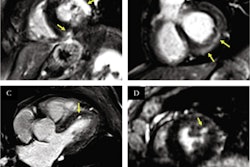
Long-term space travel causes changes in the brain anatomy of astronauts that can be detected on MRI scans, according to a study published November 1 in the New England Journal of Medicine. The findings could affect planning for long-term space travel, such as a mission to Mars.
Long-duration spaceflight appears to narrow cerebrospinal fluid (CSF) spaces and the central sulcus (the part of the brain that separates the parietal lobe from the frontal lobe and the primary motor cortex from the primary somatosensory cortex) and shifts the brain upward in the skull. This may lead to dangerous compression of nearby venous structures, noted a group led by Dr. Donna Roberts of the Medical University of South Carolina (MUSC).
"Further investigation, including repeated postflight imaging conducted after some time on Earth, is required to determine the duration and clinical significance of these changes," Roberts and colleagues wrote.
Space effects
From the beginning, humanity's space explorations have aimed to gather scientific data -- investigating not only other planets and our galaxy, but also how our bodies respond to spaceflight. But much of the latter research has focused on the effects of space on bones and muscle, rather than on astronauts' brains.
 Dr. Donna Roberts from MUSC.
Dr. Donna Roberts from MUSC."NASA has conducted significant research to understand what happens to the human body in space, particularly around bone and muscle health," Roberts told AuntMinnie.com. "But there hasn't been much about how spaceflight affects the brain."
Roberts and colleagues sought to remedy this through a NASA-funded study that explored the effects of spaceflight on the anatomical configuration of the brain and CSF.
The researchers used data provided by the NASA Lifetime Surveillance of Astronaut Health program and included 34 astronauts in the study. Of these, 18 underwent long-duration missions on the International Space Station (mean mission time, 164.8 days) and 16 underwent short-duration missions as part of the space shuttle program (mean mission time, 13.6 days).
The astronauts' brains were imaged before and after the missions, with preflight MRIs performed a mean of 287.5 days before launch (range, 18-627 days) and postflight MRIs performed a mean of 6.7 days after spaceflight (range, 1-20 days). The researchers also paired preflight and postflight MRI cine clips generated from a subgroup of astronauts who had high-resolution MRI scans -- 12 who underwent long-duration flights and six who underwent short-duration flights -- to evaluate the extent of the narrowing of CSF spaces and displacement of brain structures.
Among the 18 astronauts who undertook long missions, 17 experienced narrowing of the central sulcus (94%), while only three of the 16 astronauts who had short missions experienced this narrowing (19%), Roberts and colleagues found. Cine clips showed an upward shift of the brain after all long-duration flights (12 astronauts) and in one of six astronauts after short-duration flights. In addition, three of these 12 astronauts had optic disk edema (also called vision impairment and intracranial pressure syndrome, or VIIP) and a narrowing of the central sulcus.
"On Earth, we don't usually think about the brain moving around inside the skull, but our study showed that these astronauts' brains were shifting upward over the course of long-duration missions," Roberts told AuntMinnie.com.
MRI cine clip shows evidence of an upward shift of the brain and narrowing of cerebrospinal spaces at the top of the brain in a NASA astronaut stationed aboard the International Space Station. Courtesy of MUSC.
First step
The study is a good first step in assessing the effects of spaceflight on the brain, but further research is necessary, according to Roberts.
"We have to determine whether there truly is an association between the shifting of the brain and the development of increased pressure inside the head and blurry vision," she said. "And since the part of the brain that is being compressed is the part that controls body movement, we have to investigate whether brain structure returns to normal after some time following astronauts' return to Earth."
Additional research is particularly important as interest grows in sending astronauts to Mars -- and tourists into space, Roberts said.
"If we're trying to send people to Mars, we need to know what happens to the brain in space long term," she said. "It takes three to six months to get to Mars, and then once you're there, you have to wait for the planets to align again in order to return to Earth -- which happens about every two years. So astronauts would be spending two years exploring Mars' surface, and we have to understand whether changes in brain structure as a result of spaceflight would continue to progress."



.fFmgij6Hin.png?auto=compress%2Cformat&fit=crop&h=100&q=70&w=100)





.fFmgij6Hin.png?auto=compress%2Cformat&fit=crop&h=167&q=70&w=250)











